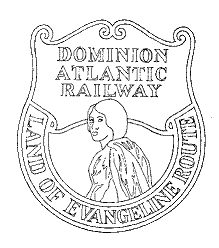
Hants County is a historical county and census division of Nova Scotia, Canada. Local government is provided by the West Hants Regional Municipality, and the Municipality of the District of East Hants.
Windsor is a community located in Hants County, Nova Scotia, Canada. It is a service centre for the western part of the county and is situated on Highway 101.

The Minas Basin is an inlet of the Bay of Fundy and a sub-basin of the Fundy Basin located in Nova Scotia, Canada. It is known for its extremely high tides.

The Dominion Atlantic Railway was a historic railway which operated in the western part of Nova Scotia in Canada, primarily through an agricultural district known as the Annapolis Valley.

The Windsor and Hantsport Railway was a 56-mile (90.1 km) railway line in Nova Scotia between Windsor Junction and New Minas with a spur at Windsor which runs several miles east, serving two gypsum quarries located at Wentworth Creek and Mantua. It suspended operations in 2011.

East Hants, officially named the Municipality of the District of East Hants, is a district municipality in Hants County, Nova Scotia, Canada. Statistics Canada classifies the district municipality as a municipal district.

The Nova Scotia Railway is a historic Canadian railway. It was composed of two lines, one connecting Richmond with Windsor, the other connecting Richmond with Pictou Landing via Truro.

The Shubenacadie Canal is a canal in central Nova Scotia, Canada. It links Halifax Harbour with the Bay of Fundy by way of the Shubenacadie River and Shubenacadie Grand Lake. Begun in 1826, it was not completed until 1861 and was closed in 1871. Currently small craft use the river and lakes, but only one lock is operational. Three of the nine locks have been restored to preserve their unique fusion of British and North American construction techniques. More extensive restoration is planned.
The Shubenacadie Valley is a Canadian rural region in central Nova Scotia.

Trunk 2 is part of the Canadian province of Nova Scotia's system of Trunk Highways. The route runs from Halifax to Fort Lawrence on the New Brunswick border. Until the 1960s, Trunk 2 was the Halifax area's most important highway link to other provinces, and was part of a longer Interprovincial Highway 2 which ended in Windsor, Ontario. The controlled access Highway 102 and Highway 104 now carry most arterial traffic in the area, while Trunk 2 serves regional and local traffic.

Route 236 is a collector road in the Canadian province of Nova Scotia.
Windsor Junction is a suburban community in Halifax Regional Municipality, Nova Scotia, Canada. It is located approximately 22 km (14 mi) north west of Downtown Halifax and approximately 3 km (1.9 mi) north of the Bedford Basin near the communities of Fall River, Lower Sackville, and Waverley.

Brooklyn is a Canadian rural community located in western Hants County, Nova Scotia with a population of 916 people in 2016.

Truro station is an intercity railway station in Truro, Nova Scotia. It is operated by Via Rail.

The Cornwallis Valley Railway (CVR) was a historic Canadian railway in Nova Scotia's Annapolis Valley. It was built in 1889 and ran 13.6 miles (21.9 km) from Kentville to Kingsport serving the Cornwallis Township area of Kings County. For most of its history, it operated as a branch line of the Dominion Atlantic Railway and was sometimes known as the "Kingsport Line".

The Kennetcook River is a river that flows through Hants County, Nova Scotia. From headwaters near the mouth of the Shubenacadie River, the Kennetcook traverses about 45 kilometres of mostly rural terrain, discharging into the Avon River at Windsor. The Kennetcook cuts through fossiliferous limestone rocks for part of its length. A tidal river near its mouth, the Kennetcook experiences a tidal bore which may be seen at Scotch Village. It is a known salmon river popular with anglers.

The Windsor and Annapolis Railway (W&AR) was a historic Canadian railway that operated in Nova Scotia's Annapolis Valley.

Kennetcook is an unincorporated community in the Canadian province of Nova Scotia, located in East Hants Municipality in Hants County.

South Maitland is an unincorporated community in the Canadian province of Nova Scotia, located in East Hants Municipality in Hants County. The community was one of the stops on the Shubenacadie Canal system and the site of a number of 19th century shipyards including the yard that built the barque Calburga in 1890, the last large square rigger to sail under a Canadian flag. The village is best known for the historic bridge built over the Shubenacadie River by the Midland Railway, part of the Dominion Atlantic Railway in 1901. Demolished in the 1990s, a surviving abutment of the railway bridge was retrofitted in 2006 by the Fundy Tidal Interpretive Centre as a lookoff and walking trail showcasing the tides of the Shubenacadie River. A decommissioned railway caboose is also preserved beside the trail.

















